How much modern biology is a fraud?
The revolutionary work of Harold Hillman MB, BSc, MRCS, PhD, and others.
©Raeto West 1999, 2000, 2022, 2023.
* New book and Internet info & Audio interview added for the first time 2012, Video added 2013
* Plus Hillman & Sartory's jointly-written The Living Cell.
* 47 Unanswered Questions
 How Much Traditional Medicine is a Fraud?
How Much Traditional Medicine is a Fraud?
Good Question! I hope to have detailed material soon from Europe.
I've just found Aixur's blog
https://www.repenser-la-medecine.com/ which seems good on reconsidering medical errors, and intentionally damaging treatments. Continental Europe, not the UK, seems best at this sort of work, possibly because of Pasteur, or because the Anglophone world is more centrally Jewish. 24-Feb-2022
Summary: Many people feel modern biology & biochemistry & medicine are overrated and unreliable; they see lack of progress with so-called 'AIDS', so-called COVID, and with degenerative diseases with age—cancer, Parkinsons, multiple sclerosis, schizophrenia, Alzheimers. They have concerns over dangerous drugs, vaccination, and interminable 'treatment' rather than cure; there are media panics, which people distrust; there are failed operations; dislike of animal experiments are typical areas of unease. However, most criticisms are ad hoc and have no general purchase on the problem.
The claim of this website is that defects in basic techniques have led in some cases to seventy years' wasted work. This has been allowed to happen through secretiveness, lack of honesty probably fed by the desire for funding, and the general expense and inaccessibility of equipment, as well as excessive compartmentalisation of the subject.
–Rae West
Note added 17 December 2022: As I'd expected, imitators of various types have appeared. I won't name any of them; what's the point in advertising nonentities? Let me emphasise that all the videos of Harold are online only because I persuaded Harold to relocate them in his University; their AV department didn't even know of them. If you've watched Harold online, or listened to him, it's probably because of me. - Rae West
Note 3 Sept 2023: Below is a sketchy article
Nothing Doing prompted by H G Wells on the difficulties of voluntary co-operation. (Wells was unaware of deliberate damage and destruction by Jews).
2012 upload. My recorded interview with Harold Hillman, then aged 65 - three hours of very detailed interview. His life's work and discoveries, and clashes with the biology establishment, in chronological order with some reference to world events.
First 90 minutes Second 90 minutes
Taken from two 90-minute audio tapes, recorded with good equipment in 1996. There is some tape hiss. The recordings are unedited in any way; there are occasional signs of stress. The agreed interview format was to proceed through Hillman's work, and life experiences, in chronological order. Intelligent people, including non-biologists, shouldn't have much difficulty with the technical material, or the academic manoeuvres.
Very Important Note: at the time of making this recording I was unaware of many ramifications of Jewish power, notably the money-printing scam and the Second World War. And that the 'holocaust' is a fraud, and that nuclear weapons are also almost certainly a fraud.
At the time of recording, I had too little idea of Jewish power. Harold gave little hint of his history; I believe his father was a jeweller, and Harold and his two brothers, who were evacuees from London for part of the Second World War, were each educated, in geology and social science, though I know little of the prior history, including entry to Britain. Harold must have been aware that some Jews were involved in medical frauds, but said nothing that I know of about it.
CONTENTS

Introduction and Overview—Biology since about 1960
About two-thirds of the work done in biology in the half-century since about 1945 is fraudulent, or, more politely, based on foundations so insecure that it will have to be rejected. This has been allowed to happen through secretiveness, lack of honesty probably fed by the desire for funding, and the general expense and inaccessibility of equipment, as well as excessive compartmentalisation of the subject. And the incompetence and dishonesty of research councils, media and civil service personnel. My piece explores this process. Many people
feel modern biology & medicine are disappointing: they vaguely sense the lack of progress with 'AIDS', Alzheimers, arthritis, cancer, Parkinsons, schizophrenia, and degenerative diseases; they may be concerned about dangerous drugs and vaccination; they may dislike animal experiments. However, most criticisms are ad hoc and have had no general purchase on the problem—until now. This piece is intended to be a radical examination, in a literal sense, of modern biology.
To impose order on my account, most of my information is arranged around the work of Dr Harold Hillman, MB, BSc, MRCS, PhD, who I've known and liked for many years. In my opinion he is a very great scientist. But there must be other actors in this drama, including people who are completely unknown to me, who may have had parallel careers.
I must stress that this piece has not been written with his approval or cooperation; it is my own work. I've often pleaded with him to put his life's work on Internet, since this is the first medium ever with this sort of freedom—a piece of luck unlikely to last. But my attempts came to nothing—I think because he was held back by a hankering after respectability in the biological/medical establishment, something incompatible with his work. I've even thought he might have sunk to the level of wanting to be a Nobel 'Laureate'.
My narrative is largely chronological, structured around Hillman's books, in the sequence he happened to write them, and what they prove. To combine science with human interest, I've added illustrative material on related subjects in way which is adapted to Internet (separate screens each contributing a piece to the puzzle), trying to throw light on the complicated systems of motives which have led to the present unhappy position.
Everything here is true—Rae West.
Setting the Scene: Diary Notes
What qualifications do I have to write about this subject? In theory, there are people better qualified than me; unfortunately, most of them are wankers. (Harold complained about my use of this word, but was mollified, or perhaps just puzzled, when I pointed out that Kingsley Amis had used it at least once in his novels—though the shade of meaning concerned with fraud is missing from his conventional usage. I also considered whether it was accurate to say he is a 'very great' scientist; perhaps 'stubborn' would do? Or a man who simply adhered to, or rediscovered, old views and ignored new errors? However, I decided 'very great' was right on the grounds that Whistler, looking through some drawings by Beardsley, said he'd been mistaken, and Beardsley was a very great artist; whereupon young Aubrey burst into tears. If Beardsley was a great artist, I think Harold can count as a great scientist). Over what is now almost a decade I have recorded careful conversations on biological topics, and collected printed material, and these, plus computer sources are what I'm drawing on.
We first met, in December 1991, after I'd contacted him, tipped off by Ivor Catt, who, however, had never made any attempt to understand Harold's views. His small lab, at Surrey University, was at the extreme end of a grey-vinyl-tile floored corridor on the ground floor of a 1960s-built technical building, with a card-swipe security system which never seemed to work. One floor above was the photocopy/ lounge/ coffee area. The lab was filled with journals and shelved papers, and things like a resuscitation pump, desiccators, a fridge with samples, gas cylinders, reagents, a gut bath—more correctly known as an isolated organ bath—and boxes of microscope slides. At that time David Jarman worked with him; an amiable man, who had managed to get himself sacked from his previous job, as I understand it, by not paying attention to his union rights, and not getting onto the permanent staff of the institution where he taught pharmacology. He co-discovered beaded fibres in white matter of the brain with Harold. He was always willing to discuss such subjects as pharmacognosy. He had a different view from Harold, maintaining, in effect, according to Harold, that academics were entitled to get away with what they could.
In 1995 Harold's lab was closed, on his retirement, which was I think more-or-less forced by the university authorities: his union representative informed him that, if he were illegally dismissed, he would have to take legal action himself. This marked the end of many years of friction over everything from foreign students being questioned inadequately in their vivas and inadequate equipment being ordered by people with a financial interest in companies, to inadequate control experiments in biological experimentation.
Harold was and is hardworking. (For example, see my poster for his 1998 lecture tour in Canada/US - probably his last.
Click here [5K]). But there was an irresolvable conflict between his beliefs and the work he found himself required to do. As with many other intellectual dissidents, he took the view that the proper thing to do is to teach the conventional view, even if it's wrong. Stepping out of line would create difficulties. So, school students should be taught the conventional views. Undergraduates should be taught the conventional views. If they became PhD students, to avoid conflict with their handlers they should still avoid questioning the received views. At any stage on the ladder there would be the risk that an outspoken attack of frankness would bring disaster. The logical conclusion seems to be that dissidents should conceal their opinions until they retired, and in fact Harold duly told me that, when he retired, he intended to "pull out all the stops." I did my best not to smile.
Anyone would imagine that a man with decades of critical work behind him would routinely apply criticism to related subjects, but it's a strange fact, which I've noticed in other such people (see for example
Gilbert Ling [25K, plus more]), that this is not the case. Harold accepted the full line on AIDS without any vestige of criticism, despite his possibly unique awareness of the shaky foundations of the 'science' which went into it. He also (e.g.) believed the 1 o'clock BBC radio news provided accurate information about the world. It's possible to construct ad hoc descriptions of such behaviour—perhaps, for example, every person carries around a quantum of scepticism, which cannot be exceeded—but the astounding psychological oddity haunts me, a baffling and incomprehensible mystery.
This attitude is reflected in his works, which in general aren't to-the-point. A perfect example is a lecture he delivered on brain research, in which he didn't state his view that the current work is a waste of time until the very last sentence! Typically—in my view!—to avoid confronting the issue directly, he begins by outlining the traditional view, however wrong it may be. In vain I pointed out that Newton didn't include a preface on Aristotelian dynamics, Vesalius didn't include engravings of structures which Galen wrongly described, and Wallace didn't start with a description of creationism. As the years had gone by, he tried other approaches to presenting his ideas—films and lecture tours—and developed his
'unanswered questions' (below) approach, trying to prompt people into replying to his 'simple' questions. (See below for typical replies). He also planned to talk with heads of public and private research institutes and university departments, with a view to asking them what, if anything, they had achieved, but these efforts in practice amounted to very little despite some valiant attempts.
We had endless disputes over phrasing and vocabulary; while I take the robust view that, once attention has been drawn to a problem, failure to debate it goes straight into the realm of fraud, he coined a new word, 'parafraud', to cover such activities as changing the subject, cancelling lectures, and not answering legitimate questions. He also has an understandable but exasperating habit of not naming names, though, by asking for details of the same story in different ways, I often managed to piece together what he thought had happened. In fact this difference of approach made it difficult for us to collaborate. It remains to be seen whether my approach will prove as unsuccessful as his.

|
|
Harold was for many years involved with the Quekett Microscopical Club, which met at the Natural History Museum, London
|
At the time we first met, he was trying to help establish an organisation, of various suggested names and acronyms, which I'll call ICAF, the 'International Committee for Academic Freedom'. (
Click for details, below ). The ground rules were never thought out; I don't know what their group would have made of Holocaust revisionists, for example, or moonwalk revisionists. And what about military secrets? What about young people? Leafing through their documents, it's not much of a caricature to say that each of them thought his own work important, and was happy to permit the others to work for them, provided they didn't attempt to intrude their own silly ideas. Various oddities surfaced; for example, the 'National Association of Scholars', an obviously worthless organisation which sent a piece the main story of which was that in about 1980 some gays and lesbians wrote to them. A faintly relevant organisation was or is the 'Council for Academic Autonomy', with Bertie Russell's son Conrad a chairman. Russell's book shows he hasn't a clue about the issues). Eventually the embryo organisation died, if it can be said to have ever lived, partly because nobody was willing to do much work for it.
Harold liked committees and spent much time in innumerable meetings of the Royal Society of Medicine, Surrey University's governing bodies, the BMA, Amnesty, the Quekett Microscopical Club in the Natural History Museum, and so on. He would say to me that organisations such as Campaign for Freedom of Information, more or less a one-man outfit, at least superficially, had "influence out of all proportion to their numbers." As far as I could judge, he had little hesitation in using the same tricks he disliked in others; for example, when chairman of Freedom to Care, the story of the bust-up with
Dick van Steenis [99K] was never released to the mere members. This organisation also was involved with child abuse victims, but seemed just as much, if not more, concerned with damage to the careers of whistle-blowers. Again, nothing like the full story ever emerged.
(I was impressed, not that it was any of my business, with his tricky financial condition; he would do GP locum work, and show visiting Americans around medical establishments. He toyed with the idea of writing thrillers, which I suspect will remain unpublished. Harold is a cousin of the late Chaim Herzog, twice president of Israel, and author of something like a neo-fascist recent autobiography; Harold told me he was one of the first people in Auschwitz, though in fact Harold's memory was wrong. I was moved once to contact the Israeli Embassy, worried at the spectacle of an original researcher in trouble, though I never told Harold. Naturally, the stupid fuckers did nothing).
The reader might at this point consult Harold's piece
'What Price Intellectual Honesty?'[77K] which I edited and put into HTML format for him. This is a short version of what might have been a long intellectual autobiography. Unfortunately, many names are omitted and many judgements avoid forthrightness.
My best guess at what will happen is that his ideas will be appropriated without credit, and the years of waste, and those responsible, hushed up. I'm reminded of an account of Thomas Hodgkin, discoverer of his eponymous disease, who was a contemporary of Addison and Bright. At Guys Hospital the latter were commemorated with statues, whereas Hodgkin had no memorial. According to his biographer, Rose, the reason was that Hodgkin was outspoken on aboriginal rights and other moral issues. I believe Hodgkin now has something like a cupboard named for him.
Harold Hillman's Publications and Work.
Book titles (as opposed to papers and articles) are in red
Dr. Harold Hillman has written and co-written six books and about 150 full-length papers, on biochemistry, biochemical techniques, cytology (cell structure and workings), neurobiology (the structure and functions of the brain and nervous system), histology (techniques of preparation of specimens for microscopy), and practical topics, notably resuscitation, death, and the death penalty. His work is important because it is radical and systematic.
1962-4 Collaboration with Prof Holger Hyden. Research into single nerve cells
1964 'The effect of visible light on ATP in solution'
1964 'The terminal phosphate bond as a transducer'
1965 'Do oscillations in biological systems originate in their substrates and nucleotides?'
1966 The Effect of Light on ATP, in Life Sciences - "When all my troubles started"
1970 'Chemical basis of epilepsy' in The Lancet
1970 'The growth of new processes from isolated dorsal and sympathetic cell bodies of rat and rabbit.' H. Hillman & Khallawan S A. Tissue and Cell .
1972 Resuscitation journal founded. Harold edited it until 1985. Elsevier. Abdominal pumping technique discovered, or rediscovered, by Rogers and Hillman. Ignored; no clinical trial.
1972 Certainty & Uncertainty in Biochemical Techniques. (First book. Surrey University Press, U.K.)
1972 T.E.S. article suggesting Highlands and Islands University
1972-4 Series of articles in Teach-In ; titles included 'Architecture, Town Planning and the Doctor', 'Air Pollution and Disease Transmission', ' War and Civil Disturbances', 'Dying and Death'
1974 'A nucleolar membrane in neurons'
1974 'The Uses of Unfixed Isolated Mammalian Nerve Cells' (in Biochemical Society Transactions)
1975 'Occam Society' founded; about 25 members. Foundered in 1977: "Nobody else wanted to do any work."
1975 'Towards a Classification of Evidence in Biological and Medical Research in Respect of its Validity'. "This is my most important philosophical overview paper."
1976 'Mechanisms of Drug Action: A New Approach'
1977 Black and white film made with Audio-Visual Dept of University of Surrey: 'Fine Structure of the Living Cell. A reconsideration.' Similar content as the 1980 book.
1977 'Value of Textbooks' letter in Nature
1979 'The Cell Re-examined' in Hospital Update
1980 'Appearance of Rat Tissues..' with Susan Sjuve in Quekett Microscopical Journal
1980 'A Re-reexamination of the fine structure of the living cell and its implications for biological education', in School Science Review
1980 'Artefacts in Electron Microscopy and the Consequences for Biological and Medical Research'
1980 'Boxing' in Resuscitation
1980 The Living Cell, Hillman & Peter Sartory. (Second book. Packard Publishing, U.K.)
1980 'An insoluble fraction of ox brain' [='brain powder'] N Ahmed & H Hillman
1981 Reply to review of 'The Living Cell' by Parish (in Quekett Microscopical Club Journal )
1981 'Simple Micromanipulation and Microdissection' (in Quekett Club Journal - Harold also gave a talk on this subject)
1981 'Vegetarianism - an alternative diet or a crazy fad?' Nursing Times
1981 Letter critical of anonymous refereeing in Biochemical Society Bulletin
1982 'Some questions not answered by the electron microscopists'
1983 'Biochemical Cytology - Has It Advanced in the Last 35 Years?' The Biologist
1983 'An unnatural way to die' from New Scientist. Capital punishment
1983 'Types of light microscopy'. H. Hillman and P. Richards in Microscopy.
1983 'Some Fundamental Theoretical and Practical Problems Associated with Neurochemical Techniques in Mammalian Studies' in Neurochemistry International . The editor would only print this alongside a 'critique' by L. Hertz
1985 *RECEPTORS1 'The Anatomical Synapse in Mammals by Light and Electron Microscopy'
1986 FILM Colour Film 'Cellular Structure of the Mammalian Brain'
1986 Cellular Structure of the Mammalian Nervous System. (Third book. ????)
1987 Colour Film: 'Effects of Staining'
1987 'Fraud versus Carelessness', Letter in Nature
1987 'How to make medical research more successful'
1987 'The effect of haematoxylin and eosin, Palmgren's and osmic acid procedures on the dimensions and appearance of isolated rabbit medullary neurons.'
1987 Open letter to referees in Times Higher Education Supplement
1987 Three letters in New Scientist . R H Michell and G C Cox attempt to answer re electron microscopy
1988 'A Rational Approach to Elucidating the Mechanism and Location of Action of a Disease Process, or a Drug, in Vivo'
1988 *RECEPTORS2 'Critique of Current Views on Receptors, and a New General Theory of Receptor Location and Action in Vivo.'
1988 'The Eyelash and Hair Follicle of the New-Born Mouse'
1988 Hansard extract
1989 'The Effects of Transmitters on the Affinity of the Insoluble Fraction of Ox Brain for Na+ and K+' N Ahmed & H Hillman
1990 'International Committee on the Promotion of Academic Freedom' (CAFAS) founded about now (and foundered later) About sixty interested people
1990? Article on HH in ' The Scientist '
1991 The Case for New Paradigms in Cell Biology and Neurobiology. (Fourth book. Edwin Mellen, U.K.)
1991 *RECEPTORS4 'A New Hypothesis for Electrical Transmission in the Mammalian Nervous System' in Medical Hypotheses
1991 *RECEPTORS3 'A Re-Examination of the Vesicle Hypothesis of Transmission in Relation to its Applicability to the Mammalian Central Nervous System.'
1991 'Resistance to the Spread of Unpopular Academic Findings and Views in Liberal Societies, Including a Personal Case' in ' Accountability in Research ' Volume 1
1991 'Some Microscopic Considerations about Cell Structure - Light Versus Electron Microscopy' in ' Microscopy '
1991 Atlas of the Cellular Structure of the Human Nervous System, Hillman & Jarman (Fifth book. Academic Press).
1991 'Fatty Acid Levels in the Brains of Schizophrenics...'
1992 Review of 'The Case for New Paradigms..' in Proceedings of RMS
1994 'New Considerations About the Structure of the Membrane of the Living Animal Cell' in Physiol. Chem. Phys. & Md. NMR. "It's an obscure journal and nobody will read it."
1994 Physiological Society Bulletin: letter from David F Horrobin deploring the society's decision not to publish papers by Jarman & Hillman
1995 Aug 'Awkward Questions in Biology' revised to 'Unanswered Questions in Biology' (for Internet Bulletin Board)
1995 Council for Academic Autonomy Colloquium on Academic Freedom and The HEFC(E)
1995 'Determining Ethical Practice Worldwide'
1995 'Dr Peccadillo and assorted sins' in Times Higher
1995 Jan Susan Greenfield; Letter to & Reply from
1995 ?July: Untitled Letter in Experienta (Birkhäuser Verlag, Basel)
1995 Feb What Price Intellectual Honesty? (full text)
1995 Aug World Medicine Conference Report
1996 July 1996 Unanswered Questions in Biology
1996 Unpublished Theory of Cancer
1996 Review in Nature of Confronting the Experts (and H's reply)
1996 ' Observer' Article on Cruelty of Electrical Stunning
1996 'Neurobiology has its Unanswered Questions' Aug 1996
1996 Review of 'The Case for New Paradigms..'
1996 'A New Look at the Cellular Structure of the Mammalian Brain'
1996 Problems of Research into Schizophrenia [32K]
1997
A Study of 131 Patients with Schizophrenia and Provision for Them
[52K]
1997 'Parafraud in Biology' (in Science and Engineering Ethics )
1997 Guardian obituary of Keith Porter includes Harold
1997 Honour in Academia in New Humanist
1998 23 Jan 1998 article in Science on 'cytoskeleton'
Added in 2012:-
1998 Internet Site
2000 'HAROLD HILLMAN...' in 'The Resuscitation Greats' series, in Resuscitation journal
2000 'Limitations of clinical and biological histology' in Medical Hypotheses
2001 'Research practices in need of examination and improvement' - in Science and Engineering Ethics
2003 'The physiology of sudden violent death' paper in Resuscitation
2003 'Electrical devices used by prison officers, police and security forces' - in 'Medicine Conflict and Survival'
2004 'Towards a Classification of Evidence in Biological and Medical Research in Respect of its Validity' - in Acta Biotheoretica
2008 EVIDENCE BASED CELL BIOLOGY, with Some Implications for Clinical Research (sixth book. Shaker Publishing, Maastricht).
2011 ONLINE VIDEOS START
2011, Feb - 'The Living Cell' film put online, with my own introduction; this may have prompted Internet activity-
2011, May - harold-hillman.com blog put online
2011, September - Hillman's three films put on Youtube by arhillman with new titles. (They seem to have been posted again later, or pirated, by 'venompangx').
2013, Jan - Link to new HD of 'The Living Cell' with my introductory material, photos, voiceover, timecode, and a 'Harry Potter'-style title sequence which might amuse people and lighten the mood (30 mins)-- [This was removed from Youtube without any warning with their usual Jewish disregard for honesty and free speech]
Try here: big-lies.org/media/hillman-1-living-cell-uncut-voiceover-1920x1080.mp4
Note for bibliophiles: Book collectors might try to collect the complete works of Harold Hillman - though this may not be easy, in view of the short print-runs of some of his books and the unduly-hasty pulping of others.
HAROLD HILLMAN'S FIRST BOOK.
1972 Certainty & Uncertainty in Biochemical Techniques. (Surrey University Press, U.K.)
This book was translated into Russian and appears to have been popular in the Soviet Union; but it seems unlikely that it had any practical effect. Harold asked Heisenberg, of 'uncertainty principle' fame, to write a preface, but Heisenberg declined on the grounds he knew nothing of the subject. Harold extends the 'uncertainty' idea to biology, not just in the single instance (observing tiny objects) of Heisenberg, but in all current biological techniques. Occasionally, there is straightforward writing - 'this technique looks at leather, not skin'. But generally it's written in a formally correct but rather impenetrable style; instead of directly stating that a technique has such-and-such flaws, the reader has to infer them. And the title ought, in my view, to have been clearer - nobody could guess, from the title, that the book is a direct challenge to existing views.
Summary by Rae West of Certainty and Uncertainty in Biochemical Techniques.
This overview is long and includes several complete chapters. It was approved by Hillman.
CONSEQUENCES OF THIS BOOK... INCLUDE 'HIV' and 'COVID' tests are defective
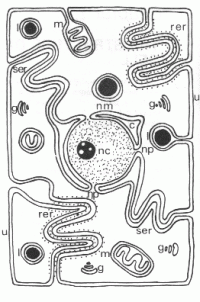
Sketch showing the incorrect view of cells, still taught today. Hillman was refused permission to reproduce textbook diagrams. This one was redrawn.
HAROLD HILLMAN'S SECOND BOOK:
1980 The Living Cell, Hillman & Peter Sartory. (Packard Publishing, U.K.)
A fairly short, well-printed, very detailed small book which examines actual cells, in life, rather than under the invasive techniques which are applied to them by biological researchers. Peter Sartory was a highly skilful observer with both microscopes and telescopes. My audio interview includes material on this book, of course. Some deductions from it include:-
• The location of DNA within cells is in doubt
• The 'Golgi Body' doesn't exist
• The cell wall as a double structure is a mistake
• The 'endoplasmic reticulum' is a myth
• 'Rough endosplasmic reticulum' (where proteins are supposedly made, on 'ribosomes') is a myth
• Sodium and potassium and other 'pumps' in cell walls are non-existent
• Idea that 'receptors' exist in the walls of cells is wrong; the whole basis of immunology is wrong, and for example 'Beta Blockers' are a mistake
Harold told me that he regretted including material on Occam's razor, and the philosophy of 'truth', because ordinary textbooks never say such things, and happily repeat errors.
The Living Cell is now (April 2019) online
here. PDF format 40MB
THIRD BOOK: 1986 Cellular Structure of the Mammalian Nervous System. (MTP Press - n.b. not MIT)
Important Book on the Structure of the Brain
Some conclusions from this book...
• 'Synapses' in the brain - the model with chemical transmission between nerves - are a mistake
• The traditional structures ('oligodendrocytes' etc) are insecurely founded
• 'Neural networks' don't model the way the brain works
• We have some explanation for the fact that people even with severe hydrocephalus can have normal brain function
FOURTH BOOK: 1991 The Case for New Paradigms in Cell Biology and Neurobiology. (Edwin Mellen, U.K.)
Originally entitled
Letter to Students of Biology of the Twenty First Century. This book is concerned with the reactions against Harold's ideas: he includes examples of discreditable behaviour taken from his attempts to get publicity, from universities, from national and international meetings of biologists, and from the media, including radio and television.
FIFTH BOOK: 1991 Atlas of the Cellular Structure of the Human Nervous System, Hillman & Jarman (Academic Press).
Conclusions from this book...
• Optical microscopy, with unfixed cells, plus staining if the stains are understood, gives a view as nearly in real-life as is obtainable
HAROLD HILLMAN'S SIXTH (and final) BOOK: 2008
Evidence Based Cell Biology, with Some Implications for Clinical Research, Harold Hillman (Shaker Publishing, Maastricht. This is, or was, available as a downloadable protected (i.e. pay) PDF file).
Summary of Hillman's life's work-
• A - Measurements and Procedures on living tissues, cells, slices, and homogenates. Including light, chemical, and electrical techniques.
• B - Structures of Cells. Concentrating on devastating criticisms of such suppositious things as ion channels, receptors, Golgi apparatus, microsomes and ribosomes, 'cytokeleton', lysosomes, parts of the nucleolus, the sliding filament muscle hypothesis.
• C - Biology. Another sceptical examination - enzymes, potential across cell walls, 'cell signalling', free radicals, and auto-immunity...
• D - Deals with what ought to be done, including in pharmacology, immunology, and education.
Distinction between science and empiricism
This distinction is very important, but often elided over by lecturers and theoreticians, probably because they don't like admitting that some of their beliefs may be unsoundly based. Some examples-
• Anaesthetics. I was, personally, astonished when I was told that nobody knows how anaesthetics work. When chemistry improved to the point that pure chemicals which barely exist in nature could be isolated. some of their properties were unpredicted. Ether and chloroform, and nitrous oxide, were found to have anaesthetic effects, which—importantly—were reversible. Today, the mechanical side is far improved: the purity, the quantity delivered, the time measurement, the gas cylinders, the ambulances, are all far more efficient. But the way they operate on the body isn't known. There are theories, and descriptions of their actions; for example, hypotheses including the cell 'membrane fluid mosaic'. (These, probably mythical constructions, are what Margaret Thatcher worked on as a chemist). It's not surprising that occasional anomalies occur.
• Drug testing. If it does what they want, they say it works according to the theory. ('Beta blockers'.) However, huge numbers of similar molecules are tested; the acid test is always empirical. Any unwanted effect is labelled a 'side effect' as though it might go away. The same sort of thing applies with insecticides, which have to be tried out on (for example) caterpillars or species of fly.
• Blood transfusions. The blood types were all found empirically: the important thing was to avoid clotting, rather than work out what made them clot.
• Antibiotics are another example: penicillin was found by accident when a mould, penicillium, was noticed to kill bacterial growths in a petri dish. Lithium, as an anti-manic depressive drug, was found by chance to make lab animals sleepy. Titanium was found by chance to work well in bone replacements: the new musculature adhered well to it. Stainless steel is another example: I doubt anybody really knows how it works. The trick is to alloy metals and test the result. An interesting point here is that many people will claim to know (e.g.) why stainless steel doesn't rust: that there's an oxide layer, for example. But if they can't predict which alloys will work, this arguably is just a form of words restating what they've found by trial.
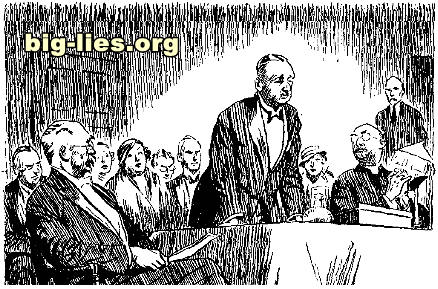
"If I tried to tell you anything about the subject, I should only display my absymal ignorance. I prefer to leave this to the lecturer."
|
Communicating the impermissible. Strategies...
[1] Writing
[2] Lecturing, films
[3] Committees, meetings
[4] Internet
[5] 'Unanswered Questions' approach:—
Request for Micrographs of Eighteen Alleged Cell Structures [4K]
The next frame shows how such questions are received... |
Nothing doing: How academic dissidents usually fail to co-operate
Note (Oct 2021): Many people now understand that the interleaving networks of conspiratorial Jews, acting internationally, were unknown to many people. They easily enfeebled and dominated many of these isolated grouplets.
Large organisations are often very firmly held together by interlinked interest groups and such forces as money, and power as compared with the people outside. Members of them may work for thirty years with people they dislike, in buildings they hate, performing tasks they dislike, keeping secrets about sharp practice and frauds for the whole of their lives. This stability is in very stark contrast indeed to the fragile bonds linking dissidents....
[1] Derek Bryce-Smith, Professor of Chemistry at Reading University. A leading activist in the campaign against leaded petrol, he regards, or regarded, lead as more dangerous than dioxins, and told me that lead resembles a radioactive material with infinite half-life. He held a patent on a method of manufacturing tetraethyl lead, which no doubt helped his reputation for personal disinterest. He habitually tested water samples from wherever he happened to be; he tipped off Balmoral that their water was high in lead, and was annoyed that the royal handlers hadn't had the courtesy to thank him. I spoke of him to Harold, who remarked dismissively "he's not a biochemist" and never challenged the toxicological bases on which anti-lead campaigners fought. Despite the fact that they lived only about forty miles apart, and weren't in direct academic competition, and shared similar humanitarian views, they never met.
[2] Maurice Pappworth was an interesting and abrasive character, who lived in Hampstead, and regarded physicians as superior to surgeons, something like Leonardo considering himself superior to Michelangelo, a sculptor covered with marble dust and physically worked hard. Pappworth investigated experiments on human subjects, and wrote a book on the topic, Human Guinea Pigs (1967), the material being taken exclusively from published papers. He showed that poor (not paying) patients were subjected to unnecessary, painful and dangerous experiments without their consent. When I knew Pappworth, I believed him to be high in the medical establishment; only years later did I realise that he'd been blackballed, assuming Harold's account to be correct. Pappworth told me he had an 'insulting room' in his garden in the Vale of Health, NW3, which I naturally took to be a joke on his tax minimisation; later I realised he wasn't permitted to describe himself as a 'consultant'. He wrote a textbook (and complained he'd been swindled or misled over the royalties—he was promised 10%, but the entire printing was sold to a wholesaler, getting him 5%) and set up a medical teaching establishment which, I gather, was highly successful. He told me he'd worked in the Second World War in a secret hospital for homosexual officers, I think on a Mediterranean island. He had somewhat fanatical Jewish beliefs on the usual subjects; I didn't have sufficient knowledge to ask difficult questions. In the 1990s he contacted Hillman, saying he was interested in his views; this was as a result of my haranguing him on the subject. Then he died. The two men never met. (Maurice Pappworth 1910-1994 RIP).
[3] Dick van Steenis is a retired GP living in Wales (see
industrial air pollution and asthma , a piece he wrote two years ago). His thesis is very simple, using methodology similar to Purdey's on organosphosphates: that air pollution causes asthma (and some cancers), and that industrial interests in league with pollution inspectorates and the medical establishment do their best to cover up this information. It seems extraordinary that the work should be done by a retired man on his own, when the entire national resources of the health industries haven't bothered to collate the information. Unfortunately, there was a financial problem with the funding of this research, as a result of which van Steenis fell out with the organisation of which Harold was or is chairman. Despite the theoretical allegiance to free speech and open organisational information, the full story never came out. Harold told me that, since he'd been elected chairman, in effect he was entitled to give them the information he chose. He would appear to have no objection to using the same techniques he objects to in others. Van Steenis' work remains rather obscure - I've only recently put it on this web site, and he claims to be a year or two behind schedule. I doubt whether he's spoken to Harold for years.
[4] Gilbert Ling's career is somewhat parallel to Hillman's; they knew each other. Ling also developed 'controversial' (but probably true) views, and had resulting career problems. Gilbert Ling on the Cell Membrane  , unfortunately incorporating much doubtful material.
, unfortunately incorporating much doubtful material.
Dr. Ling objects. Dr. Ling objected to the above statement; for correspondence between us on his website, or rather from me as he has failed to reply, click on the link.
[5] H. G. Wells writing about the difficulties of co-operating:–
All that is now quite familiar to everyone. What concerns us more directly here are those meetings and movements and discussions that occurred when the idea of the League of Nations was being shaped. These deliberations brought home to me the confused divergence of historical preoccupations among those taking part in them. Their minds were full of broken scraps of history, irrational political prejudices, impossible analogies. Everyone saw the idea from a different angle and seemed prepared to realise it by the hastiest of compromises. The Outline of History was the direct outcome of the experience I gathered in these discussions. At first, in conjunction with L. S. Woolf and one or two others, I tried to organise a Research Committee, which would set itself to think out the full significance and possibilities of this great idea. We made William Archer, who was badly out of a job just then, the salaried secretary of this body. With much internal friction we compiled The Idea of a League of Nations, Prolegomena to the Study of World Organisation, and The Way to the League of Nations: A Brief Sketch of the Practical Steps needed for the Formation of a League. These booklets are still available for the collector. Then President Wilson came to Europe and we were swept aside, because he had his own ideas, and very crude ideas they were, of a League that would make the world safe for democracy. But the difficulty of producing these two reports opened my eyes to the enormous obstacles in the way of all volunteered co-operation. It seemed impossible to hold a team together. They differed upon endless points and they would not come together to hammer them out. They were all too intent upon what they considered more immediately important things. Our chief financial supporter deserted us to go off wool-gathering upon his own lines. He could not see what need there was for all this highbrow research. But we were all going off upon our own lines. We had already disintegrated before we were disregarded.
I regret to say I can't find the source of this extract. I think it must have been from the second volume of Wells's
Experiment in Autobiography (1934), where I suspect newer editions have been reset and censored.
Wells was almost entirely Jew-blind; he had some superficial awareness. If he'd taken the trouble to talk with Hilaire Belloc about Jews, or to have been published by a non-Jewish publisher after some discussion, he might have been a much more significant figure.
Harold Hillman tried to found the 'International Campaign for Academic Freedom' with these people:-
•
Ivor Catt to whom I'm grateful for assembling his list of intellectual dissidents many years ago. He now has his own websites (updated Oct 2013; there are, confusingly, several of his sites online) on which you can try to assess his claim to have revolutionised electromagnetic theory. Another piece, on my site, big-lies.org, deals with the psychology of technical employees under hire-and-fire based on his experiences in the early US computer hardware industry. Catt, typically for his age group, has no grasp of worldwide Jewish networking, and thinks only in terms of employability.
•
Christian Schwabe (biochemist) tried to discredit evolutionary theory, relying on biochemical techniques, which 'proved' structures existed which couldn't have evolved. Schwabe naturally thought this disproves Darwinism. Instead, it's supporting evidence that the techniques are defective. Hillman could presumably have pointed this out, but didn't like to. This is my archived copy of his website.(He may have updated it; try
this site.
•
Brian Martin (an American in Australia. I'd guess either a Jew or dominated by Jews).
This is a piece on academic freedom 
•
AIDS dissidents including Louis Pascal (American) and Hiram Caton, who lived in Australia. The link is to my piece which includes their not very successful attempts to debunk the HIV fraud.
• Theo Theocharis, a dissident in physics.
'When Did the Science Wars Start?' outlines his claim to have started the 'science wars' over the, in my view, extremely feeble 1996 Sokal hoax.
outlines his claim to have started the 'science wars' over the, in my view, extremely feeble 1996 Sokal hoax.
•Gordon Moran is another interesting character associated with this group, first contacted as a result of a newspaper piece about his work: he uncovered a fascinating piece of bogus art history in Siena, an equestrian portrait of highly questionable authenticity. His initial point of friction was the Kunsthistorisches Institut, Florence, apparently an art research library which censored out his point of view. (Unfortunately there is absolutely nothing about this on Internet, except the titles of his papers in library journals. Try searching for Guidoriccio or Guido Riccio). His book Silencing Scientists and Scholars in Other Fields: Power, Paradigm Controls, Peer Review and Scholarly Communications ($73.25 hardback, $39.50 paperback) was published in 1998. Perhaps ironically, the price suggests the book is intended for the library market.
• Halton Arp, a revisionist astrophysicist, was discussed, though I don't think they contacted him.

Animals and Vegetarianism
Harold was a vegetarian most of his life. He was converted by one of his brothers. He told me: "Every time you drink milk, male calves die," as he drank his soya milk. J B S Haldane maintained that many physiologists were vegetarians, as they had detailed knowledge of the pain and the decompositional processes of slaughtered animals. He disliked killing animals, but regarded animal experimentation as unavoidable. However, he developed procedures for killing with minimal pain. This was partly as a result of seeing a perfectly cruelty-free Swedish lab technician killing a rabbit in a painful way, by injection of air, because that was the method that was the way she'd been taught.
These ethical concerns led him to investigate capital punishment methods. He was awarded a joke prize for this, in fact: the Jewish-controlled IgNobel Pize. As far as I know he never investigated non-lethal pain, though he was involved with anti-torture groups and Amnesty International.
 The Vegetarian Conscience
The Vegetarian Conscience A survey of vegetarianism.
 Animal Slaughter for Food
Animal Slaughter for Food A physiologist [Harold Hillman, in fact] examines slaughter and pain.
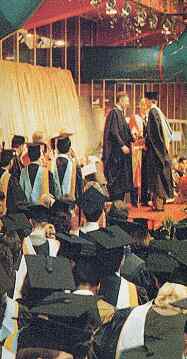
Universities and Careerism
Harold was not very impressed with universities, though he had a good grasp of their economic impact: he suggested a new university in the Scottish highlands, though he was vague on the costs. He disliked the American-style division of subjects into modules, since the interconnections and difficulties between topics could be concealed or evaded. Difficult points can be removed. And dissidents are easy to spot and remove, in the long passage from early exams to what security there may be. Teachers, polytechnic lecturers, or technicians can all have their work blocked off. Harold regretted seeing young people start of the work he regarded as futile: what he described as the religious part of biology, wasting their lives on dogma and credos and sacred texts. He had a large fund of stories of corruption—inadequate Ph D students, fake claims of book authorship, fake exam result claims, theft of equipment, misuse of funds. He managed to retain his position at Surrey University, which included a succession of personal slights against him, only by a continuous fight and by impeccably correct behaviour. But I don't think he ever developed a theory, or description, of the way in which massive science fraud can be a paying proposition, in the manner of NASA.
 How to save dissident views from the orthodoxy
How to save dissident views from the orthodoxy suggests an intellectual Hippocratic oath, a code of ethics for (e.g.) peer reviewers, and public monitoring of meetings of grant giving bodies - desiderata no doubt based on his own experiences of these things.
'47 Unanswered Questions' from 1996 predated my website; transferred to it from Usenet.
Other papers and news items by Harold Hillman and/or myself scanned or taken from computer files with permission.
First uploaded 98-03-03 Revised 98-06-15 Gilbert Ling link added 99-01-10
This larger version: first under-construction upload 99-07-11.
Susan Greenfield & BBC added 2000-07-04.
Site disappeared c. 2001.
Audio interviews uploaded 2012-04-28.
Titled and commented 'The Living Cell' link to Youtube 2013-01-13.
Oct 2021 changes hoping to conform to translations
Mar 2022 uploaded rediscovered videos made from films. Note on his Judaism.
This version with added Pappworth material 16 April 2022
Note on imitators and censors 17 December 2022
© Rae West. All rights reserved.
This site is https://www.big-lies.org
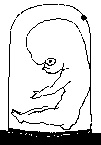




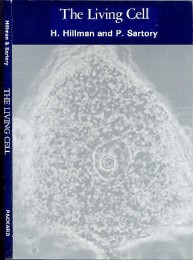

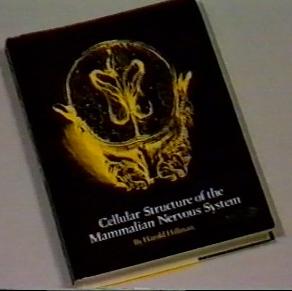
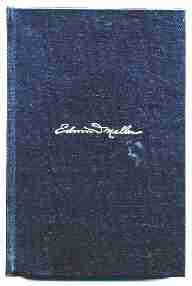
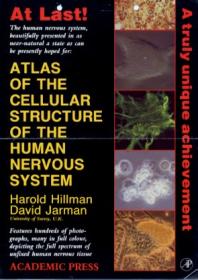




 outlines his claim to have started the 'science wars' over the, in my view, extremely feeble 1996 Sokal hoax.
outlines his claim to have started the 'science wars' over the, in my view, extremely feeble 1996 Sokal hoax. 
